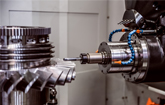Hydraulic Metering Pump Market Surges to USD 5.5 Billion by 2033, Propelled by 6.2% CAGR - Verified Market Reports®
The Hydraulic Metering Pump Market is witnessing steady growth driven by rising demand for precise fluid handling in industries such as water treatment, oil & gas, chemical processing, and pharmaceuticals. Market expansion is propelled by increasing emphasis on accuracy, efficiency, and automation in dosing applications.
LEWES, Del., Aug. 26, 2025 /PRNewswire/ -- The Global Hydraulic Metering Pump Market is projected to grow at a CAGR of 6.2% from 2026 to 2033, according to a new report published by Verified Market Reports®. The report reveals that the market was valued at USD 3.2 Billion in 2024 and is expected to reach USD 5.5 Billion by the end of the forecast period.
Download PDF Brochure: https://www.verifiedmarketreports.com/download-sample/?rid=807512
Browse in-depth TOC on Hydraulic Metering Pump Market
202 – Pages
126 – Tables
37 – Figures
Scope of The Report
REPORT ATTRIBUTES |
DETAILS |
STUDY PERIOD |
2023-2033 |
BASE YEAR |
2024 |
FORECAST PERIOD |
2026-2033 |
HISTORICAL PERIOD |
2023 |
ESTIMATED PERIOD |
2025 |
UNIT |
Value (USD Billion) |
KEY COMPANIES PROFILED |
Grundfos, IDEX, SPX Flow, Dover, Lewa, Verder International, Prominent, Seko, Milton Roy, Lutz-Jesco, Iwaki, Tefen |
SEGMENTS COVERED |
By Type, By Application, By End User Industry, By Design, By Flow Rate, By Geography |
CUSTOMIZATION SCOPE |
Free report customization (equivalent to up to 4 analyst working days) with purchase. Addition or alteration to country, regional & segment scope |
Global Hydraulic Metering Pump Market Overview
Hydraulic Metering Pump Market: Trends and Opportunities
- Precision dosing at process scale: End users in water & wastewater, chemicals, and oil & gas are prioritizing API 675–compliant, closed-loop systems that deliver repeatable accuracy (±1%) under varying pressures, driving upgrades from legacy mechanical dosing to hydraulically actuated diaphragm metering architectures.
- Digitalization and smart telemetry: Plants are adopting IIoT-enabled controllers, condition monitoring, and remote parameterization to optimize stroke length/frequency, cut chemical overfeed, and shrink lifecycle cost via predictive maintenance and data-driven OEE dashboards.
- Corrosion and abrasion breakthroughs: Advances in PTFE & multilayer diaphragms, duplex/super duplex steels, and ceramic ball-check assemblies are extending MTBF in aggressive media (acids, brines, polymers), opening higher-value applications in lithium, pulp & paper, and produced-water treatment.
- Energy and ESG alignment: Variable-speed drives and hydraulic efficiency improvements reduce power draw per unit flow, supporting decarbonization KPIs and enabling greener chemical management strategies under tightening environmental norms.
- Modular skids and rapid deployment: Pre-engineered chemical dosing skids with integrated tanks, sensors, and safety interlocks speed commissioning for desalination, municipal plants, and downstream refining turnarounds, compressing time-to-value.
- Regional performance divergence: North America and Europe are replacing aging assets to meet EPA/EU emissions and water standards, while Asia-Pacific is the growth engine on the back of industrialization, petrochemicals capacity, and large public water programs.
Executive Market Narrative
Hydraulic metering pumps occupy a mission-critical niche wherever exact chemical dosing under pressure is non-negotiable—chlorination and pH control in municipal plants, demulsifiers and scale inhibitors in upstream and midstream oil & gas, corrosion inhibitors and coagulants in industrial water loops, and catalyst dosing in polymerization trains. For boardroom stakeholders, the business case now extends beyond volumetric accuracy: leadership teams want digitally orchestrated, safer, and energy-aware systems that bolster compliance and profitability. The competitive frontier is shifting toward intelligent dosing ecosystems—pumps plus sensors, analytics, and closed-loop logic—capable of quantifying chemical savings, uptime, and ESG impact in quarterly KPI packs.
Demand-side tailwinds pivot on three pillars. First, water stress and regulatory scrutiny are intensifying project pipelines in desalination and reuse, moving operators to higher-spec diaphragm technology with leak-free operation. Second, process industries are raising product quality thresholds and batch consistency, translating to tighter dosing tolerances and automatic compensation for viscosity, temperature, and suction-head variations. Third, workforce constraints in maintenance teams are catalyzing condition-based service models, where remote diagnostics, alarm rationalization, and parts forecasting convert unplanned downtime into predictable interventions. At the same time, procurement leaders face constraints: capex sensitivity in cyclical end markets, the need to standardize spares across multi-plant footprints, and the imperative to de-risk HSE exposure through built-in safeguards such as double-diaphragm leak detection, pressure relief valves, and ATEX-rated drives.
From a product strategy lens, winners will focus on four vectors: (1) precision hydraulics with wide turndown (≥1000:1) preserving accuracy at low stroke rates; (2) materials science that expands chemical compatibility while lowering total cost of ownership; (3) digital twins and API-first software that plug into SCADA/MES without brittle custom work; and (4) lifecycle monetization—service contracts, performance guarantees, and outcome-based dosing (chemical savings & compliance SLAs) that resonate with CFOs and plant managers alike. The addressable opportunity is also expanding through modular dosing skids for brownfield retrofits and rapid-response water remediation, where standardized platforms can be configured to spec and shipped quickly.
Hydraulic Metering Pump Market Segmentation and Application Momentum
By end use, water & wastewater remains the volume anchor, propelled by disinfection, coagulation, and nutrient removal programs. Oil & gas sustains higher-margin demand for high-pressure, high-accuracy injection in upstream flow assurance and refining additives. Chemicals and petrochemicals leverage metering pumps for catalyst feeds and neutralization steps, while power generation applies them to boiler feedwater treatment and flue-gas conditioning. In food & beverage, hygienic dosing of CIP chemicals and additives is rising with stricter quality regimes. Across segments, the shift from manual to automated setpoints, coupled with data logging for audit trails, is redefining specification checklists and bid evaluations.
What are the most influential regulatory-driven market drivers and how should procurement leaders calibrate specification, compliance, and lifetime cost?
Regulatory escalation is the single strongest structural driver. Environmental norms for effluents, disinfection byproducts, and chemical handling have tightened, raising the bar on accuracy, containment, and traceability. In North America, EPA water programs and state-level discharge permits amplify compliance obligations across municipal and industrial users. In Europe, frameworks such as REACH and the Pressure Equipment Directive heighten material and design scrutiny, while Health & Safety regulations emphasize containment and risk mitigation in chemical handling. Across emerging markets, national pollution control boards and ministries of environment are introducing stricter wastewater standards, intensifying adoption of closed, leak-free diaphragm designs.
For procurement leaders, the strategic response is threefold. First, specify API 675–aligned hydraulic diaphragm pumps with double-diaphragm leak detection, integrated pressure relief, and pulsation dampening to secure process stability and safety compliance. Second, require digital enablers—stroke-position feedback, flow verification, and Modbus/Profinet connectivity—to create auditable dosing records, support automated alarms, and satisfy inspectors. Third, total cost modeling should incorporate chemical overfeed avoidance, energy draw, and spare-part commonality across plants. A multi-year TCO lens typically justifies higher initial outlay through avoided fines, fewer unplanned outages, and chemical savings measurable within a few quarters. Vendors able to document compliance mapping and provide validation protocols reduce project risk and ease commissioning.
To Purchase a Comprehensive Report Analysis: https://www.verifiedmarketreports.com/ask-for-discount/?rid=807512
What are the leading technical restraints in hydraulic metering pump adoption and which application innovations unlock ROI despite those constraints?
Key restraints include sensitivity to suction conditions (NPSH, entrained gas), viscosity swings, and pulsation that can disturb upstream instrumentation. Maintenance skill gaps can slow mean time to repair, and in cost-constrained projects, buyers may default to lower-spec mechanical options that seem cheaper on day one. There is also the challenge of integrating pumps into heterogeneous automation stacks, where cybersecurity, protocol mismatches, and alarm overload can derail digital value capture.
Three innovation streams are overcoming these headwinds. First, advanced hydraulics and smart drives sustain metering accuracy across wide turndown, while auto-degassing heads and spring-loaded check valves stabilize flow in off-design conditions. Second, materials upgrades—multilayer PTFE diaphragms, zirconia checks, and super duplex wetted parts—extend service life in abrasive and chloride-rich environments, reducing lifecycle cost even in harsh media like produced water and brines. Third, application-layer intelligence closes the loop: inline flow verification, density/viscosity compensation, and adaptive control logic regulate dose in real time, cutting chemical consumption by quantifiable percentages. Skid-based standardization with factory acceptance testing (FAT) compresses integration risk. For plant engineers, the ROI case centers on fewer callouts, documentable chemical savings, and verifiable compliance—all of which translate into value that finance teams can book.
Hydraulic Metering Pump Market Geographic Dominance & Regulatory Context
- North America (Revenue leadership through compliance and asset replacement): Municipal and industrial water users are investing to meet stringent discharge permits and safe drinking water objectives administered by federal and state authorities. EPA frameworks, combined with OSHA requirements for chemical handling safety, favor double-diaphragm designs with leak detection, relief valves, and automated shutoff interlocks. Oil & gas and midstream pipeline operators specify API 675–compliant units for high-pressure chemical injection, sustaining premium demand in upstream and refining hubs. Replacement cycles in older utilities are creating a robust installed-base upgrade opportunity with significant service annuities.
- Europe (High-spec adoption driven by environmental policy): Enforcement under the EU Water Framework Directive, REACH, and the Pressure Equipment Directive elevates material compatibility and design traceability, supporting rapid uptake of corrosion-resistant hydraulics and hygienic configurations. Energy efficiency agendas encourage variable-speed operation and smart control to reduce dosing overages. Mature industrial clusters in Germany, the Nordics, France, Italy, and the UK sustain steady opex-driven orders, with a pivot toward fully instrumented skids that provide audit-ready dosing logs.
- Asia-Pacific (Volume growth engine): Industrialization, petrochemical expansions, and extensive municipal water projects underpin the fastest growth trajectory. National ministries and pollution control boards across China, India, and Southeast Asia are tightening effluent and potable water standards, spurring adoption of reliable dosing platforms in desalination, reuse, and industrial ZLD (zero liquid discharge) schemes. Public funding for water resilience and industrial value-add—highlighted by multilateral development indicators—creates a structurally expanding base for metering solutions, especially where population density and water stress intersect. As plants move from manual dosing to automated control loops, demand for connected, easily maintained hydraulic diaphragm pumps accelerates.
- Middle East & Africa (Desalination-led opportunities): Large-scale seawater reverse osmosis assets and oil & gas operations anchor demand. Projects emphasize chemical dosing reliability under high salinity and temperature swings, with materials engineered for chlorides and abrasive particulates. Government-led water security programs and industrial diversification support multi-year project visibility and a healthy pipeline for standardized dosing skids.
- Latin America (Selective capex but rising compliance): Municipal modernization and mining/metals water treatment are key pockets of opportunity. As national environmental regulators tighten effluent norms and water reuse mandates, operators are upgrading to leak-free diaphragm systems and adding verification instrumentation to satisfy audits. Currency cycles and public funding constraints make modular, service-backed offerings—where uptime and chemistry savings are contracted outcomes—particularly attractive.
- Across regions, authoritative guidance from global institutions shapes buying criteria. Public health objectives echo the need for accurate disinfection and chemical management in potable water. Economic development indicators highlight the linkage between industrial growth and water infrastructure upgrades, underscoring why metering accuracy and reliability are central to regulatory compliance and community outcomes. Environmental protection policies emphasize containment and traceability; as a result, procurement specifications increasingly require documented accuracy at turndown, built-in overpressure safeguards, and digital data streams to prove performance. Whether mandated by national environmental agencies, regional water frameworks, or municipal utility standards, the operating reality is converging: precision, safety, and data integrity are no longer nice-to-haves but license-to-operate conditions.
Hydraulic Metering Pump Market: Key Players Shaping the Future
Major players, including Grundfos, IDEX, SPX Flow, Dover, Lewa, Verder International, Prominent, Seko, Milton Roy, Lutz-Jesco, Iwaki, Tefen and more, play a pivotal role in shaping the future of the Hydraulic Metering Pump Market. Financial statements, product benchmarking, and SWOT analysis provide valuable insights into the industry's key players.
Hydraulic Metering Pump Market: Segments Analysis
Based on the research, Verified Market Reports® has segmented the global Hydraulic Metering Pump Market into Type, Application, End User Industry, Design, Flow Rate, Geography.
By Type
- Diaphragm Pumps
- Gear Pumps
- Piston Pumps
- Peristaltic Pumps
- Other Types
By Application
- Chemicals
- Water and Wastewater Treatment
- Oil and Gas
- Pharmaceuticals
- Food and Beverage
- Mining
- Others
By End User Industry
- Industrial
- Agriculture
- Construction
- Automotive
- Healthcare
By Design
- Standard Pumps
- High Pressure Pumps
- Explosion-proof Pumps
- Corrosive Liquid Handling Pumps
By Flow Rate
- Low Flow Rate (up to 100 LPH)
- Medium Flow Rate (100 LPH to 500 LPH)
- High Flow Rate (above 500 LPH)
Hydraulic Metering Pump Market, By Geography
- North America
- U.S
- Canada
- Mexico
- Europe
- Germany
- France
- U.K
- Rest of Europe
- Asia Pacific
- China
- Japan
- India
- Rest of Asia Pacific
- ROW
- Middle East & Africa
- Latin America
Browse Related Reports:
Global Diaphragm Metering Pump Market Size By Product Type (Electromagnetic Diaphragm Pumps, Pneumatic Diaphragm Pumps), By Application (Chemical Processing, Water Treatment), By End-User Industry (Agriculture, Mining), By Flow Rate (Low Flow Rate (up to 10 L/min), Medium Flow Rate (10 L/min to 50 L/min)), By End-User (Hospitals, Oncology Clinics), By Geographic Scope And Forecast
Global Fluid Metering Pumps Market Size By Type of Fluid Metering Pump (Positive Displacement Pumps, Peristaltic Pumps), By Application Industry (Water & Wastewater Treatment, Oil & Gas), By Flow Rate Capacity (Low Flow (up to 100 LPH), Medium Flow (100 LPH to 500 LPH)), By Pump Mechanism (Electric Pumps, Pneumatic Pumps), By End-User (Commercial, Industrial), By Geographic Scope And Forecast
Global Hydraulic Actuated Diaphragm Metering Pump Market Size By Type (Manual Hydraulic Actuated Diaphragm Metering Pump, Automatic Hydraulic Actuated Diaphragm Metering Pump), By Capacity (Up to 50 L/h, 50 L/h to 100 L/h), By Application (Chemical Processing, Water & Wastewater Treatment), By Material (Cast Iron, Stainless Steel), By Mounting Type (Flange Mount, Shaft Mount), By Geographic Scope And Forecast
Global Mechanical Diaphragm Type Metering Pumps Market Size By Application (Chemical Processing, Water and Wastewater Treatment), By Operating Principle (Positive Displacement, Vacuum Based), By Material of Construction (Stainless Steel, Plastic), By Size and Capacity (Low Capacity (up to 10 L/h), Medium Capacity (10 L/h to 100 L/h)), By Automation Level (Fully Automated Machines, Semi-Automated Machines), By Geographic Scope And Forecast
Global Mechanical Diaphragm Metering Pumps Market Size By Application (Chemical Processing, Water & Wastewater Treatment), By End-User Industry (Industrial, Agriculture), By Type (Single Head, Double Head), By Material (Plastic, Stainless Steel), By Power Source (Electric, Pneumatic), By Geographic Scope And Forecast
About Us
Verified Market Reports® stands at the forefront as a global leader in Research and Consulting, offering unparalleled analytical research solutions that empower organizations with the insights needed for critical business decisions. Celebrating 10+ years of service, Verified Market Reports has been instrumental in providing founders and companies with precise, up-to-date research data.
With a team of 500+ Analysts and subject matter experts, Verified Market Reports leverages internationally recognized research methodologies for data collection and analyses, covering over 15,000 high impact and niche markets. This robust team ensures data integrity and offers insights that are both informative and actionable, tailored to the strategic needs of businesses across various industries.
Verified Market Reports' domain expertise is recognized across 14 key industries, including Semiconductor & Electronics, Healthcare & Pharmaceuticals, Energy, Technology, Automobiles, Defense, Mining, Manufacturing, Retail, and Agriculture & Food. In-depth market analysis cover over 52 countries, with advanced data collection methods and sophisticated research techniques being utilized. This approach allows for actionable insights to be furnished by seasoned analysts, equipping clients with the essential knowledge necessary for critical revenue decisions across these varied and vital industries.
Verified Market Reports® is also a member of ESOMAR, an organization renowned for setting the benchmark in ethical and professional standards in market research. This affiliation highlights Verified Market Reports' dedication to conducting research with integrity and reliability, ensuring that the insights offered are not only valuable but also ethically sourced and respected worldwide.
Contact Us
Mr. Edwyne Fernandes
Verified Market Reports®
US: +1 (650)-781-4080
US Toll Free: +1 (800)-782-1768
Email: sales@verifiedmarketreports.com
Web: https://www.verifiedmarketreports.com/
Logo: https://mma.prnewswire.com/media/2486715/5468917/VM_Reports.jpg





Share this article